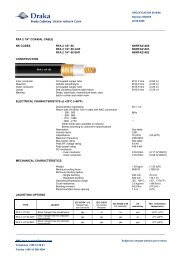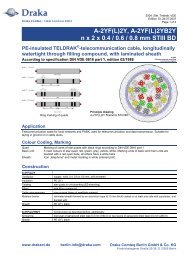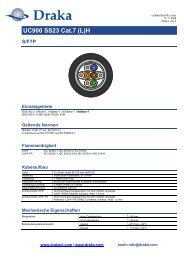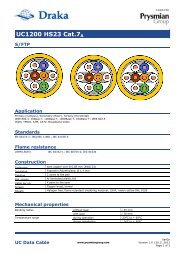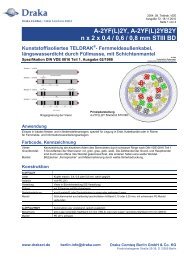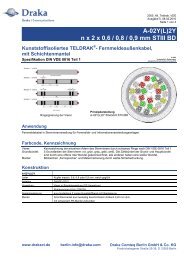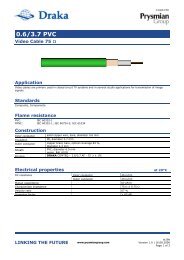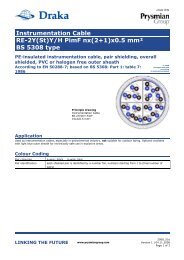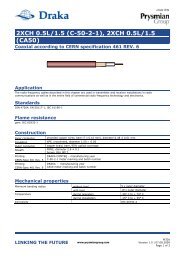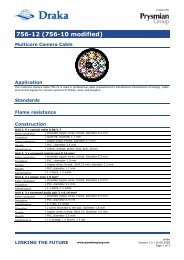ezPREP ® | Loose Tube Cable - Draka Communications - Prysmian
ezPREP ® | Loose Tube Cable - Draka Communications - Prysmian
ezPREP ® | Loose Tube Cable - Draka Communications - Prysmian
Create successful ePaper yourself
Turn your PDF publications into a flip-book with our unique Google optimized e-Paper software.
Table of Contents<br />
1.0 Scope........................................................................pg. 1<br />
2.0 Safety......................................................................pg. 1<br />
3.0 Key Points............................................................pg. 1-2<br />
4.0 Reference Drawing.........................................pg. 2<br />
5.0 Tool and Materials Needed........................pg. 2<br />
6.0 End of <strong>Cable</strong> Access........................................pg. 2-5<br />
7.0 Midspan Access.................................................pg. 6-8<br />
1.0 Scope<br />
This document provides instruction for the preparation and handling<br />
of <strong>Draka</strong> <strong>ezPREP</strong><strong>®</strong> <strong>Loose</strong> <strong>Tube</strong> fiber optic cable. The instructions in<br />
this document explain how to prepare end openings and midspan<br />
openings of loose tube fiber optic cable. When this cable is used in<br />
conjunction with splice closures, cabinets, pedestals, hardware, etc.,<br />
the user must obtain installation procedures from the appropriate<br />
component manufacturers. Failure to adhere to preparation and<br />
handling procedures may void the cable warranty.<br />
Please call if you have any questions at 1-800-879-9862<br />
2.0 Safety<br />
2.1 <strong>Draka</strong> recommends the use of approved personal protective<br />
equipment in this procedure.<br />
2.2 Wear safety glasses and gloves, and use solvents in well<br />
ventilated areas.<br />
2.3 Never look directly into the end of a fiber that may be carrying<br />
laser light. Laser light may be invisible and can damage your eyes.<br />
Viewing it directly does not cause pain. The iris of the eye will not<br />
close involuntarily as when viewing a bright light. Consequently,<br />
serious damage to the retina of the eye is possible. Should accidental<br />
eye exposure to laser light be suspected, arrange for an eye examination<br />
immediately.<br />
2.4 DO NOT use magnifiers in the presence of laser radiation.<br />
Diffused laser light can cause eye damage if focused with optical<br />
instruments. Should accidental eye exposure be suspected, arrange<br />
for an eye exam immediately.<br />
2.5 A Material Safety Data Sheet (MSDS) for Fiber Optic <strong>Cable</strong> is<br />
also available. Call 1-800-879-9862.<br />
1<br />
<strong>ezPREP</strong> <strong>®</strong> <strong>Loose</strong> <strong>Tube</strong><br />
Preparation & Handling Procedure<br />
<strong>Prysmian</strong> Group, <strong>Draka</strong> — a Brand of the <strong>Prysmian</strong> Group | www.prysmiangroup.com<br />
2512 Penny Road Claremont North Carolina 28610-0039<br />
1-800-879-9862 or 1-800-669-0808<br />
3.0 Key Points<br />
3.1 Do not leave more than the rated length of exposed (bare)<br />
buffer tube in closures, cabinets, pedestals, etc. Exposing buffer<br />
tubes beyond the rated length may lead to attenuation increase.<br />
If a longer buffer tube storage length is needed, remove the buffer<br />
tube and place the fiber in splice trays or inside spiral wrap.<br />
Maximum Express <strong>Tube</strong> Storage Length<br />
<strong>Cable</strong> Table <strong>ezPREP</strong> <strong>ezPREP</strong> <strong>ezPREP</strong><br />
(Jan-2007 & beyond) Heavy Duty (2002-2006)<br />
Buffer <strong>Tube</strong> 2.0/2.5/2.7 mm 3.0mm 2.5mm<br />
Diameter (mm)<br />
Exposed 20 feet 20 feet 8 feet<br />
Buffer <strong>Tube</strong> (6 m) (6 m) (2.4m)<br />
Rated Length<br />
Effective January 2007, standard <strong>Draka</strong> <strong>ezPREP</strong><strong>®</strong> loose tube single-mode<br />
cables with 2.0/2.5/2.7mm polypropylene tubes are rated for 20’ (6 m).<br />
3.2 Do not allow blades or sharp edges to contact the fibers.<br />
3.3 Central strength member MUST be tightly secured to prevent<br />
expansion/contraction and potential attenuation increase.<br />
3.4 Jacket sheath MUST be tightly secured inside the closure,<br />
pedestal, cabinet, etc., to prevent expansion/contraction and<br />
potential attenuation increase.<br />
3.5 Do not exceed the minimum bend radius.<br />
3.6 Do not exceed the maximum pull tension.<br />
3.7 When removing buffer tubes keep fibers pulled tight and straight<br />
to prevent fiber breaks. Pull the buffer tube off of the fibers rather<br />
than pushing. DO NOT attempt to remove more than 4 feet of buffer<br />
tube at a time. If the tube temperature is ≤ 0 o C (32 o F) and the tube<br />
is gel-filled, DO NOT REMOVE more than 2 feet of tube at a time.<br />
3.8 Do not bend buffer tubes at sharp angles while removing the<br />
jacket, armor, yarns, or strength members.<br />
3.9 A <strong>Draka</strong> ezTOOLS | Buffer <strong>Tube</strong> Access Tool is highly recommended<br />
for midspan access of fibers in the buffer tubes to prevent<br />
fiber damage. Call 1-800-879-9862 to order.<br />
PRO1-V6 3/28/2012-V6
2<br />
4.0 Reference Drawing<br />
...............................<br />
................<br />
Central Strength Member<br />
Optical Fibers<br />
....................................<br />
...............................<br />
..........................<br />
.......................<br />
....................<br />
...............<br />
Armored <strong>Loose</strong> <strong>Tube</strong><br />
5.0 Tools and Materials Needed<br />
Flexible Buffer <strong>Tube</strong>s<br />
Water Blocking<br />
Binders<br />
Strength Yarns<br />
Ripcord<br />
Armor<br />
(corrugated steel)<br />
Jacket<br />
(polyethylene)<br />
[+] <strong>Cable</strong> ring cutter, sheath knife, or utility knife<br />
(alternative-ezTOOLS <strong>Cable</strong> Jacket Slitter)<br />
[+] Pliers – needle nose, diagonal, or linesman<br />
[+] Diagonal cutters<br />
[+] Scissors or snips<br />
[+] Flat-tip screwdriver<br />
[+] <strong>Cable</strong> cleaning solution D’Gel<br />
[+] Lint free wipes<br />
[+] 99% propanol alcohol<br />
[+] Disposable rags<br />
<strong>Prysmian</strong> Group, <strong>Draka</strong> — a Brand of the <strong>Prysmian</strong> Group | www.prysmiangroup.com<br />
2512 Penny Road Claremont, North Carolina 28610-0039<br />
1-800-879-9862 or 1-800-669-0808<br />
6.0 End of <strong>Cable</strong> Access Procedure<br />
Quick Reference Checklist<br />
1. Remove jacket and armoring (if applicable)<br />
[+] Measure access length and make ring cuts.<br />
[+] Score armor, flex and pull off 6” section from cable end<br />
[+] Notch armor/sheath and pull ripcords.<br />
[+] Remove jacket and armor.<br />
2. Prepare the cable core.<br />
[+] Cut and remove yarns, binders, unnecessary filler rods.<br />
[+] Separate buffer tubes from central strength member (CSM).<br />
[+] Cut CSM to proper length.<br />
3. Prepare buffer tubes and fibers.<br />
[+] Score & remove buffer tubes in < 4 foot sections. For gel-filled<br />
tubes ≤ 0 o C (32 o F), DO NOT REMOVED more than 2 ft. sections.<br />
<strong>Draka</strong>’s ezTOOLS | Buffer <strong>Tube</strong> Access Tool is recommended<br />
for midspan access.<br />
[+] Do not leave more than the rated length of exposed<br />
buffer tube.<br />
[+] Clean fibers and prepare for splicing.<br />
Maximum Express <strong>Tube</strong> Storage Length<br />
<strong>Cable</strong> Table <strong>ezPREP</strong> <strong>ezPREP</strong> <strong>ezPREP</strong><br />
(Jan-2007 & beyond) Heavy Duty (2002-2006)<br />
Buffer <strong>Tube</strong> 2.0/2.5/2.7 mm 3.0mm 2.5mm<br />
Diameter (mm)<br />
Exposed 20 feet 20 feet 8 feet<br />
Buffer <strong>Tube</strong> (6 m) (6 m) (2.4m)<br />
Rated Length<br />
Effective January 2007, standard <strong>Draka</strong> <strong>ezPREP</strong><strong>®</strong> loose tube single-mode<br />
cables with 2.0/2.5/2.7mm polypropylene tubes are rated for 20’ (6 m).<br />
Step-by-Step: End of <strong>Cable</strong> Access<br />
6.1 Measure and Ring Cut #1<br />
Determine the length of cable needed to access by referring to the<br />
instructions of the closure, pedestal, cabinet, etc manufacturer.<br />
Make a ring cut at this distance from the end of the cable.<br />
CAUTION: Only a shallow cut is necessary to remove<br />
the jacket. Cutting too deeply through the jacket may result<br />
in damage to the ripcords, armor, buffer tubes, and fibers.<br />
6.2 Ring Cut #2<br />
Make a second ring cut 6 inches (15 cm) from the end of the<br />
cable, again being careful not to cut too deeply.<br />
PRO1-V6 3/28/2012-V6
PRO1-V6 3/28/2012-V6<br />
6.3 Jacket and armor removal (preferred method)<br />
FOR ARMORED CABLE, score the armor at ring cut #2. Flex the<br />
cable at the ring cut to make sure the jacket is cut all the way<br />
through and to break the armor (if applicable).<br />
FOR NON-ARMORED CABLE, score the jacket longitudinal down the<br />
cable. Make several shallow cut passes. Flex the cable to separate<br />
the jacket.<br />
Grabbing the cable end, pull the 6” section of jacket/armor off the<br />
end of the cable.<br />
6.4 Jacket and/or armor removal (alternative method)<br />
Slit 6” of the outer jacket from the second ring cut to the end of<br />
the cable, and remove the jacket with needle nose pliers.<br />
6.5 Ripcord Notches<br />
Use diagonal cutters to notch the jacket (and armor, if applicable)<br />
near the ripcords. This helps start the pull of the ripcords and<br />
prevents breaking ripcord.<br />
6.6 Knot the Ripcords<br />
Tie a knot in the end of each ripcord. This will help hold the ripcord<br />
in the jaws of the pliers.<br />
6.7 Pull Ripcords<br />
Grasp one end of a ripcord in the jaws of needle nose pliers. Twist<br />
the pliers to wrap the ripcord around them, pull the ripcord through<br />
the jacket to the first ring cut.<br />
NOTE: For armored cable, consult the closure, pedestal, cabinets,<br />
or hardware manufacturer procedure and make sure to leave<br />
enough armor in front of the ring-cut to be used for grounding.<br />
6.8 Remove Jacket/Armor<br />
Peel the jacket and armor (if applicable) away from the cable core<br />
and discard it.<br />
NOTE:<br />
If the cable has an inner jacket, repeat steps 1 through 8.<br />
CAUTION: Care must be taken not to cut into the buffer<br />
tubes when scoring the inner jacket. Keep the center of the<br />
cable as straight as possible and avoid bending the buffer tubes<br />
at sharp angles, which can break fibers.<br />
<strong>Prysmian</strong> Group, <strong>Draka</strong> — a Brand of the <strong>Prysmian</strong> Group | www.prysmiangroup.com<br />
2512 Penny Road Claremont, North Carolina 28610-0039<br />
1-800-879-9862 or 1-800-669-0808<br />
3
6.9 Strength Yarn<br />
Refer to the closure, pedestal, cabinets, and hardware manufacturer<br />
procedure to determine how much strength yarn to leave exposed for<br />
anchoring. Use snips to cut and remove the excess length of yarns<br />
from the cable core.<br />
6.10 Binders<br />
Use scissors and/or diagonal cutters to cut and remove binders<br />
from cable core.<br />
CAUTION: Care must be taken not to avoid piercing or<br />
cutting the buffer<br />
6.11 Buffer <strong>Tube</strong>s<br />
Separate the individual buffer tubes from the central strength<br />
member (CSM) and filler rods. Keep the buffer tubes straight as<br />
possible to prevent kinking the tubes and breaking fibers.<br />
4<br />
<strong>Prysmian</strong> Group, <strong>Draka</strong> — a Brand of the <strong>Prysmian</strong> Group | www.prysmiangroup.com<br />
2512 Penny Road Claremont, North Carolina 28610-0039<br />
1-800-879-9862 or 1-800-669-0808<br />
6.12 Central Strength Member (CSM)<br />
Refer to the closure, pedestal, or cabinet manufacturer procedure<br />
to determine how much CSM to leave exposed for anchoring. Using<br />
lineman’s pliers, cut the excess CSM and filler rods and remove them<br />
from the cable core.<br />
CAUTION: Securing the central strength member inside<br />
the closure, pedestal, or cabinet is a critical element to prevent<br />
expansion/contraction and potential attenuation increases.<br />
6.13 Buffer <strong>Tube</strong> Cleaning<br />
If handling a flooded cable, thoroughly clean all buffer tubes with<br />
cable cleaning solution and a rag. All <strong>Draka</strong> <strong>ezPREP</strong><strong>®</strong> <strong>Loose</strong> <strong>Tube</strong><br />
cables utilize dry water-swellable binders and tapes that eliminate<br />
this step.<br />
6.14 Buffer <strong>Tube</strong> Scoring<br />
Starting from the end of the tube, measure 1 to 4 feet, then score<br />
each tube individually with rotations of the coaxial ring cutter.<br />
If the tube temperature is ≤ 0 o C (32 o F) and the tube is gel-filled,<br />
DO NOT REMOVE more than 2 feet of tube at a time.<br />
6.15 Removing the Buffer <strong>Tube</strong> and Exposing Fibers<br />
CAUTION: Care must be exercised in this step to prevent<br />
cutting or breaking fibers while removing the buffer tube.<br />
Grasp the tube on each side of the score mark. Flex the tube in all<br />
directions to separate the tube at the scored mark.<br />
PRO1-V6 3/28/2012-V6
PRO1-V6 3/28/2012-V6<br />
CAUTION: Hold the buffer tube tight and straight while<br />
pulling the tube off the fibers. Apply back-tension to the fibers<br />
while pulling the tube off.<br />
Pull <strong>Tube</strong> Off vs<br />
Push <strong>Tube</strong><br />
Repeat the removal of tubes in 1 to 4 foot sections as described<br />
in steps 14 and 15 until the desired length of fiber is exposed.<br />
Maximum Express <strong>Tube</strong> Storage Length<br />
<strong>Cable</strong> Table <strong>ezPREP</strong> <strong>ezPREP</strong> <strong>ezPREP</strong><br />
(Jan-2007 & beyond) Heavy Duty (2002-2006)<br />
Buffer <strong>Tube</strong> 2.0/2.5/2.7 mm 3.0mm 2.5mm<br />
Diameter (mm)<br />
Exposed 20 feet 20 feet 8 feet<br />
Buffer <strong>Tube</strong> (6 m) (6 m) (2.4m)<br />
Rated Length<br />
Effective January 2007, standard <strong>Draka</strong> <strong>ezPREP</strong><strong>®</strong> loose tube single-mode<br />
cables with 2.0/2.5/2.7mm polypropylene tubes are rated for 20’ (6 m).<br />
6.16 Fiber Cleaning<br />
Clean the fibers using a lint free wipe with D-gel, followed by a<br />
lint-free wipe with 99% propanol alcohol.<br />
7.0 Midspan Access Procedure<br />
Technical Note<br />
Similar cable designs such as ADSS can have 24 fibers per tube<br />
that contain two bundles of 12 fibers each. The bundles are<br />
distinguished by blue and orange binder threads.<br />
Tools and Materials Needed<br />
[+] <strong>Cable</strong> ring cutter, sheath knife, or utility knife<br />
(alternatively, an ezACCESS cable jacket slitter)<br />
[+] Needle nose pliers<br />
[+] Diagonal cutters<br />
[+] Scissors or snips<br />
[+] Flat-tip screwdriver<br />
[+] Pliers<br />
[+] Procedure for closure, cabinet,<br />
pedestal hardware<br />
[+] <strong>Draka</strong> ezACCESS Midspan Access Tool<br />
[+] <strong>Cable</strong> cleaning solution or D’Gel<br />
[+] Cleaning rags<br />
[+] Lint free wipes<br />
[+] 99% propanol alcohol<br />
Quick Reference Checklist<br />
1. Remove jacket and armoring<br />
[+] Determine access point and make 2 ring cuts<br />
8-12 inches apart.<br />
[+] Slit jacket between ring cuts & remove.<br />
[+] Cut and pry away the armor.<br />
[+] Notch jacket and pull ripcords an equal distance<br />
both directions from switchback to desired length.<br />
[+] Remove jacket and armor.<br />
2. Prepare the cable core.<br />
[+] Cut and remove yarns and binders.<br />
[+] Separate buffer tubes from central strength<br />
member (CSM).<br />
[+] Cut CSM and remove filler rods (if present).<br />
3. Prepare buffer tubes and fibers.<br />
[+] Clean buffer tubes (as needed).<br />
[+] Refer to “Procedure for Midspan Access of Fibers in<br />
Buffer <strong>Tube</strong>s”. <strong>Draka</strong> recommends the ezACCESS<br />
Buffer <strong>Tube</strong> Access Tool. Call 1-800-879-9862<br />
to order.<br />
4. Ensure appropriate buffer tube length.<br />
[+] Do not leave more than the rated length of exposed<br />
buffer tube.<br />
<strong>Prysmian</strong> Group, <strong>Draka</strong> — a Brand of the <strong>Prysmian</strong> Group | www.prysmiangroup.com<br />
2512 Penny Road Claremont, North Carolina 28610-0039<br />
1-800-879-9862 or 1-800-669-0808<br />
5
7<br />
Armored<br />
<strong>Loose</strong> <strong>Tube</strong><br />
...............................<br />
................<br />
Central Strength Member<br />
Optical Fibers<br />
....................................<br />
...............................<br />
..........................<br />
.......................<br />
....................<br />
...............<br />
6 Pull Ripcords in opposite<br />
directions to Ring Cut #3<br />
and #4<br />
3<br />
Flexible Buffer <strong>Tube</strong>s<br />
Water Blocking<br />
Binders<br />
Strength Yarns<br />
Ripcord<br />
Armor<br />
(corrugated steel)<br />
Jacket<br />
(polyethylene)<br />
Slit and remove the jacket and armor<br />
between Ring Cut #1 and #2<br />
Pull Ripcord Pull Ripcord<br />
12“<br />
4 Ring Cut #3: 1 Ring Cut #1: 2 Ring Cut #2: 5 Ring Cut #4:<br />
Opening determined Locate desired point 12 inches away Opening determined<br />
by closure, cabinet, and make Ring Cut #1 from Ring Cut # 1 by closure, cabinet,<br />
pedestal manufacturer<br />
pedestal manufacturer<br />
6<br />
Remove jacket, armor,<br />
yarns, filler rods<br />
Step-by-Step: Midspan Access<br />
7.1 Ring Cut #1:<br />
Determine the access/splice point location and make a ring cut at<br />
this location.<br />
CAUTION: Only a shallow cut is necessary to remove the<br />
jacket. Cutting too deeply through the jacket can result in<br />
unintentional damage to the ripcords, armor or buffer tubes.<br />
7.2 Ring Cut #2:<br />
Make a second ring cut 8 to 12 inches (20-30 cm) from the first<br />
ring cut, again being careful not to cut too deeply.<br />
<strong>Prysmian</strong> Group, <strong>Draka</strong> — a Brand of the <strong>Prysmian</strong> Group | www.prysmiangroup.com<br />
2512 Penny Road Claremont, North Carolina 28610-0039<br />
1-800-879-9862 or 1-800-669-0808<br />
7.3 Jacket Removal:<br />
Use a cable or utility knife to slit the outer jacket between Ring<br />
Cut #1 and Ring Cut #2. Remove the jacket in a single piece.<br />
Make several shallow cut passes.<br />
7.4 Armor removal:<br />
At the ring cut, cut the armor (if applicable) with diagonal cutters<br />
and then use a flat-tip screwdriver to pry it away, exposing the<br />
ripcords. Remove the Armor.<br />
7.5 Ripcord Notches:<br />
Use diagonal cutters to notch the jacket (and armor, if applicable)<br />
near the ripcords. This helps start the pull of the ripcords.<br />
PRO1-V6 3/28/2012-V6
PRO1-V6 3/28/2012-V6<br />
7.6 Knot in the Ripcords:<br />
Cut the ripcords in the center of the opening. Tie a knot in the<br />
end of each ripcord.<br />
7.7 Pull Ripcord and Find Switchback Point:<br />
Grasp one end of a ripcord in the jaws of needle nose pliers.<br />
Turn the pliers to wrap the ripcord around them, then pull the<br />
ripcord through the jacket to the nearest switchback (stranding<br />
reversal point).<br />
NOTE:<br />
For armored cable, consult the closure, pedestal, cabinet,<br />
or hardware manufacturer’s procedure and make sure to leave<br />
enough armor in front of the ring cut to be used for grounding.<br />
7.8 Ring Cut #3 and #4<br />
Refer to the closure, pedestal, cabinet, and hardware manufacturer’s<br />
procedure to determine the required access length.<br />
Mark equal distance on both sides of the switchback to provide<br />
the predetermined access length, then ring cut the jacket at each<br />
mark. Make Ring Cut #3 and #4.<br />
7.9 Pull Ripcords to Ring Cut #3 and #4<br />
Pull the ripcords through the jacket and open the jacket to Ring<br />
#3 and #4. Remove the jacket and armor.<br />
NOTE:<br />
For armored cable, consult the closure, pedestal, cabinet,<br />
or hardware manufacturer’s procedure and make sure to leave<br />
enough armor in front of the ring cut to be used for grounding.<br />
7.10 Strength Yarn<br />
Refer to the closure, pedestal, cabinet, or hardware manufacturer’s<br />
procedure to determine how much strength yarn to leave exposed<br />
for anchoring. Use snips to cut and remove the excess length of<br />
yarns from the cable core.<br />
CAUTION: Do not exceed the length specified for the<br />
cable design. (3.0 Key Points, Section 3.1) Only a shallow cut<br />
is necessary to remove the jacket. Cutting too deeply through<br />
the jacket can result in unintentional damage to the ripcords,<br />
armor or buffer tubes.<br />
<strong>Prysmian</strong> Group, <strong>Draka</strong> — a Brand of the <strong>Prysmian</strong> Group | www.prysmiangroup.com<br />
2512 Penny Road Claremont, North Carolina 28610-0039<br />
1-800-879-9862 or 1-800-669-0808<br />
7
PRO1-V6 3/28/2012-V6<br />
7.11 Binders<br />
Use a seam ripper and/or diagonal cutters to cut and remove<br />
binders from around the cable core.<br />
CAUTION: Take care to avoid piercing or cutting the<br />
buffer tubes.<br />
7.12 Buffer <strong>Tube</strong>s<br />
Separate the individual buffer tubes from the central strength<br />
member (CSM) and filler rods.<br />
7.13 Central Strength Member (CSM)<br />
Refer to the closure, pedestal, cabinet, or hardware manufacturer’s<br />
procedure to determine how much CSM to leave exposed for anchoring.<br />
Using lineman’s pliers, cut the excess CSM and filler rods and<br />
remove them from the cable core.<br />
7.14 Buffer <strong>Tube</strong> Cleaning<br />
If handling a flooded cable, thoroughly clean all buffer tubes<br />
with D’Gel cleaning solution and a rag. All <strong>ezPREP</strong> loose tube<br />
cables utilize dry water-swellable binders and tapes that eliminates<br />
this step.<br />
7.15 Buffer <strong>Tube</strong> Access<br />
Refer to <strong>Draka</strong>’s “Procedure for Midspan Access of Fibers in<br />
Buffer <strong>Tube</strong>s”.<br />
<strong>Prysmian</strong> Group, <strong>Draka</strong> — a Brand of the <strong>Prysmian</strong> Group | www.prysmiangroup.com<br />
2512 Penny Road Claremont, North Carolina 28610-0039<br />
1-800-879-9862 or 1-800-669-0808<br />
8




